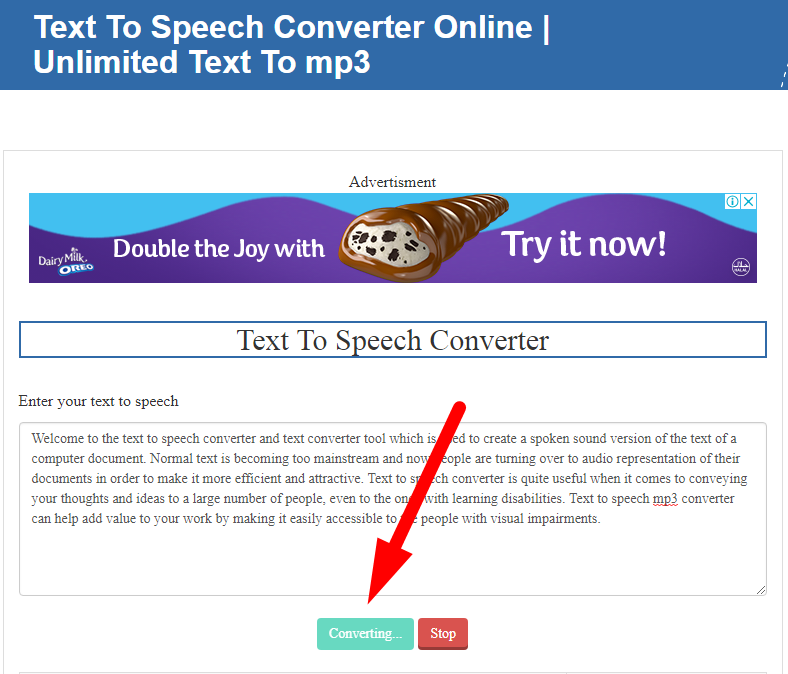
- #Speech to text online .wav how to#
- #Speech to text online .wav full#
- #Speech to text online .wav android#
- #Speech to text online .wav software#
Otter also provides you with some additional features. You can export as TXT, PDF, Microsoft Word. This makes it easy to share via email or store on shared servers. When the audio has been transcribed, you can export it if required. All of this means the text is useful in the day-to-day operation of your business.
#Speech to text online .wav software#
Otter is a powerful piece of software that automatically generates tags, allows you to search through the text, and different members of your team can access the transcription to, comment, highlight, and even add photos. There’s a scrubber bar to let you go through the audio of your transcription and listen back, too. Even the reliable AI of Otter makes the odd error, so you can hit the Edit button and make changes if needed.

You can read through it and check that it makes sense and seems correct. Otter will transcribe the text, and when the processing is finished, the text will appear in the window. A recording means that you can make the file in real time in your browser, whereas import lets you find a WAV file on your computer and upload it. Once you have signed in to Otter, you will have the chance to either record or import audio. Otter.ai Pro, Business, and Enterprise plans all allow you to import WAV files and reliably transcribe them into text to use however you please. It’s possible to find a WAV to text converter online, but many of the services out there either restrict the length of recording you can upload, or do a poor job of giving an accurate transcription of what was said. AAC, MP3, M4A, WAV, WMA, and a variety of Video formats, too. For example, the Voice Notes app on iPhone records in M4A by default.įreeware such as Audacity, combined with a quality USB microphone, can easily give you a quality WAV file to use.
#Speech to text online .wav android#
iPhones and many Android phones can record WAV files, but only with third-party applications allowing you to increase the quality of the default file that records audio. You can create a WAV recording on your computer or on a variety of mobile devices. WAV files are generally much larger than MP3s due to the extra data. This means more data to convert the WAV file to text and a better chance of accurate transcription. WAV files are lossless, meaning they haven’t been compressed. To verify support, see Language and voice support for the Speech service.Wherever possible, you should use a WAV file. For more information, see Custom Speech and Speech to text REST API.Ĭustomization options vary by language or locale. It can also be used to improve recognition based for the specific audio conditions of the application by providing audio data with reference transcriptions. The base model works very well in most speech recognition scenarios.Ī custom model can be used to augment the base model to improve recognition of domain-specific vocabulary specific to the application by providing text data to train the model. When you make a speech recognition request, the most recent base model for each supported language is used by default. The base model is pre-trained with dialects and phonetics representing a variety of common domains. Out of the box, speech recognition utilizes a Universal Language Model as a base model that is trained with Microsoft-owned data and reflects commonly used spoken language. For more information, see Speech service pricing.

You can conserve resources if the custom speech model is only used for batch transcription. A custom speech model can be used for real-time speech to text, speech translation, and batch transcription.Ī hosted deployment endpoint isn't required to use Custom Speech with the Batch transcription API. With Custom Speech, you can evaluate and improve the accuracy of speech recognition for your applications and products. For Speech CLI help with batch transcriptions, run the following command:

#Speech to text online .wav how to#
Speech to text REST API: To get started, see How to use batch transcription and Batch transcription samples (REST).Transcriptions, captions, or subtitles for pre-recorded audio.Use batch transcription for applications that need to transcribe audio in bulk such as: You can point to audio files with a shared access signature (SAS) URI and asynchronously receive transcription results. Batch transcriptionīatch transcription is used to transcribe a large amount of audio in storage. Real-time speech to text is available via the Speech SDK and the Speech CLI. Transcriptions, captions, or subtitles for live meetings.Use real-time speech to text for applications that need to transcribe audio in real-time such as: With real-time speech to text, the audio is transcribed as speech is recognized from a microphone or file.
#Speech to text online .wav full#
To compare pricing of real-time to batch transcription, see Speech service pricing.įor a full list of available speech to text languages, see Language and voice support.


 0 kommentar(er)
0 kommentar(er)
